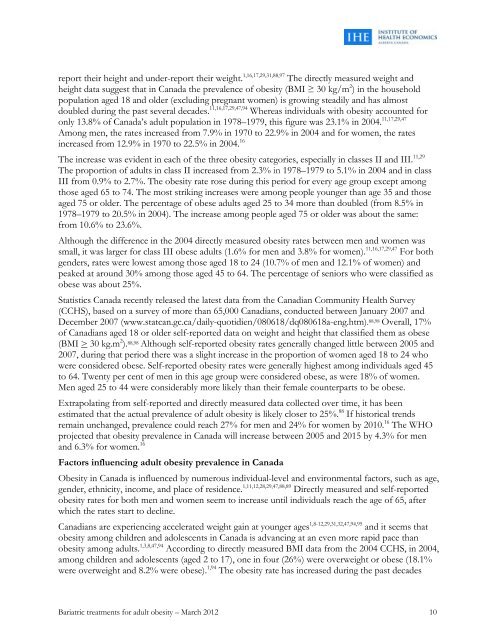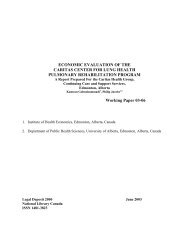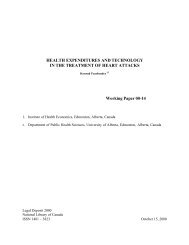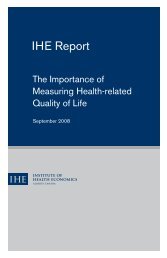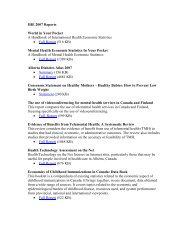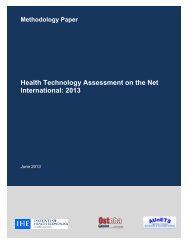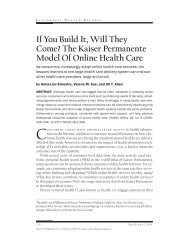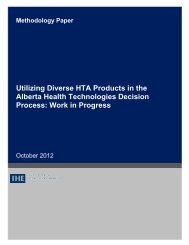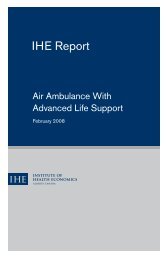eport their height and under-report their weight. 1,16,17,29,31,88,97 The directly measured weight andheight data suggest that in Canada the prevalence <strong>of</strong> <strong>obesity</strong> (BMI ≥ 30 kg/m 2 ) in the householdpopulation aged 18 and older (excluding pregnant women) is growing steadily and has almostdoubled during the past several decades. 11,16,17,29,47,94 Whereas individuals with <strong>obesity</strong> accounted <strong>for</strong>only 13.8% <strong>of</strong> Canada’s <strong>adult</strong> population in 1978–1979, this figure was 23.1% in 2004. 11,17,29,47Among men, the rates increased from 7.9% in 1970 to 22.9% in 2004 and <strong>for</strong> women, the ratesincreased from 12.9% in 1970 to 22.5% in 2004. 16The increase was evident in each <strong>of</strong> the three <strong>obesity</strong> categories, especially in classes II and III. 11,29The proportion <strong>of</strong> <strong>adult</strong>s in class II increased from 2.3% in 1978–1979 to 5.1% in 2004 and in classIII from 0.9% to 2.7%. The <strong>obesity</strong> rate rose during this period <strong>for</strong> every age group except amongthose aged 65 to 74. The most striking increases were among people younger than age 35 and thoseaged 75 or older. The percentage <strong>of</strong> obese <strong>adult</strong>s aged 25 to 34 more than doubled (from 8.5% in1978–1979 to 20.5% in 2004). The increase among people aged 75 or older was about the same:from 10.6% to 23.6%.Although the difference in the 2004 directly measured <strong>obesity</strong> rates between men and women wassmall, it was larger <strong>for</strong> class III obese <strong>adult</strong>s (1.6% <strong>for</strong> men and 3.8% <strong>for</strong> women). 11,16,17,29,47 For bothgenders, rates were lowest among those aged 18 to 24 (10.7% <strong>of</strong> men and 12.1% <strong>of</strong> women) andpeaked at around 30% among those aged 45 to 64. The percentage <strong>of</strong> seniors who were classified asobese was about 25%.Statistics Canada recently released the latest data from the Canadian Community <strong>Health</strong> Survey(CCHS), based on a survey <strong>of</strong> more than 65,000 Canadians, conducted between January 2007 andDecember 2007 (www.statcan.gc.ca/daily-quotidien/080618/dq080618a-eng.htm). 88,98 Overall, 17%<strong>of</strong> Canadians aged 18 or older self-reported data on weight and height that classified them as obese(BMI > 30 kg.m 2 ). 88,98 Although self-reported <strong>obesity</strong> rates generally changed little between 2005 and2007, during that period there was a slight increase in the proportion <strong>of</strong> women aged 18 to 24 whowere considered obese. Self-reported <strong>obesity</strong> rates were generally highest among individuals aged 45to 64. Twenty per cent <strong>of</strong> men in this age group were considered obese, as were 18% <strong>of</strong> women.Men aged 25 to 44 were considerably more likely than their female counterparts to be obese.Extrapolating from self-reported and directly measured data collected over time, it has beenestimated that the actual prevalence <strong>of</strong> <strong>adult</strong> <strong>obesity</strong> is likely closer to 25%. 88 If historical trendsremain unchanged, prevalence could reach 27% <strong>for</strong> men and 24% <strong>for</strong> women by 2010. 16 The WHOprojected that <strong>obesity</strong> prevalence in Canada will increase between 2005 and 2015 by 4.3% <strong>for</strong> menand 6.3% <strong>for</strong> women. 16Factors influencing <strong>adult</strong> <strong>obesity</strong> prevalence in CanadaObesity in Canada is influenced by numerous individual-level and environmental factors, such as age,gender, ethnicity, income, and place <strong>of</strong> residence. 1,11,12,28,29,47,88,89 Directly measured and self-reported<strong>obesity</strong> rates <strong>for</strong> both men and women seem to increase until individuals reach the age <strong>of</strong> 65, afterwhich the rates start to decline.Canadians are experiencing accelerated weight gain at younger ages 1,8-12,29,31,32,47,94,95 and it seems that<strong>obesity</strong> among children and adolescents in Canada is advancing at an even more rapid pace than<strong>obesity</strong> among <strong>adult</strong>s. 1,3,8,47,94 According to directly measured BMI data from the 2004 CCHS, in 2004,among children and adolescents (aged 2 to 17), one in four (26%) were overweight or obese (18.1%were overweight and 8.2% were obese). 1,94 The <strong>obesity</strong> rate has increased during the past decades<strong>Bariatric</strong> <strong>treatments</strong> <strong>for</strong> <strong>adult</strong> <strong>obesity</strong> – March 2012 10
from 2% to 10% among boys and from 2% to 9% among girls. 94 It appears that children living inlow-income families are more likely to be overweight than those living in higher-income families. 1There is evidence to suggest that parental <strong>obesity</strong> increases the risk <strong>of</strong> <strong>of</strong>fspring <strong>obesity</strong>. 8In the 2007 CCHS, self-reported rates <strong>of</strong> <strong>obesity</strong> among youth aged 12 to 17 were 6.8% <strong>for</strong> boysand 2.9% <strong>for</strong> girls. 88 Given the recent <strong>obesity</strong> trends among children and youth, the prevalence <strong>of</strong><strong>obesity</strong> among <strong>adult</strong>s will likely continue to increase as the current generation <strong>of</strong> children enter<strong>adult</strong>hood. 1,3,88,94 Childhood <strong>obesity</strong> not only increases the risk <strong>of</strong> <strong>obesity</strong> in <strong>adult</strong>hood, it can alsocontribute to the early development <strong>of</strong> serious health conditions such as T2DM, heart disease, andhigh blood pressure, as well as psychosocial problems. 1,16,88,94Obesity is an important health issue among Aboriginal populations in Canada. 1,11,29,31,88,95,96,99 Selfreportedand directly measured data from the CCHS indicate that, among the major ethnic groups,Aboriginal people (living <strong>of</strong>f reserve) have the highest prevalence <strong>of</strong> <strong>obesity</strong> and a significantlyhigher <strong>obesity</strong> rate than the national average. 1,11,29,31,99 Ktazmarzyk recently investigated ethnicdifferences in <strong>obesity</strong> and physical activity among Canadians aged 2 to 64 using data from the 2004CCHS and found a higher <strong>obesity</strong> prevalence among Aboriginals (37.8%) than among non-Aboriginals (22.6%). 99 Data from 2007 CCHS show that <strong>obesity</strong> rates are higher among <strong>of</strong>f-reserveAboriginal <strong>adult</strong>s compared to non-Aboriginal people (24.8% versus 16.6%). 88 Other Canadianstudies have also documented the high prevalence <strong>of</strong> <strong>obesity</strong> among Aboriginal people. 31Recent immigrant status appears to be protective against <strong>obesity</strong>. 52,89,95 Cross-sectional data from the1994 National Population <strong>Health</strong> Survey (NPHS) suggest that the length <strong>of</strong> time since immigrationis an important risk factor <strong>for</strong> excess weight <strong>for</strong> women, regardless <strong>of</strong> ethnic origin, and <strong>for</strong> men <strong>of</strong>Asian origin after controlling <strong>for</strong> socio-demographic and lifestyle correlates. 95 These results suggestthat the Canadian lifestyle, also imported into Aboriginal communities, could constitute anobesigenic environment <strong>for</strong> previously healthy immigrants. A 2003 round table meeting highlightedthe links between the environment, <strong>obesity</strong>, and health (www.cihr-irsc.gc.ca/e/21597.html).According to the presentations and discussions <strong>of</strong> this meeting, during the past decades Canadianshave experienced a paradigm shift characterized by fundamental changes in how they live in andconstruct their environment. This shift has had an impact on both <strong>obesity</strong> prevalence and the health<strong>of</strong> Canadians.Gadalla used self-reported data from the 2005 CCHS to examine a range <strong>of</strong> socio-demographic,economic, physical health, and behavioural correlates <strong>of</strong> <strong>obesity</strong>, as well as the associations between<strong>obesity</strong> and mood and anxiety disorders. 52 Bivariate chi-square tests revealed a significant association(p < .0005) between <strong>obesity</strong> and gender, age, living arrangement, length <strong>of</strong> time in Canada, educationlevel, number <strong>of</strong> chronic physical conditions, limitations in daily living activities, smoking frequency,and level <strong>of</strong> physical activity. 52 The prevalence <strong>of</strong> <strong>obesity</strong> increased steadily with advancing age andthe number <strong>of</strong> chronic physical conditions and decreased steadily with higher education and physicalactivity levels. The prevalence <strong>of</strong> <strong>obesity</strong> among individuals born in Canada was more than doublethat prevalence among recent immigrants. Findings from this research also revealed significantlyelevated levels <strong>of</strong> <strong>obesity</strong> in persons living with a partner compared to those not living with a partner,in non-smokers as compared to smokers, and in persons with functional limitations as compared tothose with no such limitations. Adjusting <strong>for</strong> the above-listed variables, the odds <strong>of</strong> <strong>obesity</strong> remainedsignificantly higher in individuals with mood disorders (with or without anxiety) than in those withneither mood nor anxiety disorders.<strong>Bariatric</strong> <strong>treatments</strong> <strong>for</strong> <strong>adult</strong> <strong>obesity</strong> – March 2012 11
- Page 1 and 2: Alberta STE ReportBariatric treatme
- Page 3 and 4: Alberta STE ReportBariatric treatme
- Page 5 and 6: EXECUTIVE SUMMARYSocial and System
- Page 7 and 8: Three surgical procedures—adjusta
- Page 9: Costs of Bariatric Surgery and Pote
- Page 12 and 13: Regulatory status .................
- Page 14 and 15: TABLES AND FIGURESSection One: Soci
- Page 16 and 17: ABBREVIATIONSAll abbreviations that
- Page 18 and 19: LYMmMAMDMUHCNANHLBINHSNICENIHNNHNPH
- Page 20 and 21: Bariatric physician: a licensed Doc
- Page 22 and 23: High-density lipoprotein (HDL): a f
- Page 24 and 25: Very-low-calorie diet (VLCD): a die
- Page 26 and 27: Additional Internet searches were c
- Page 28 and 29: This report addresses obesity in ad
- Page 30 and 31: Many systemic factors have been ide
- Page 32 and 33: Severe obesity is associated with d
- Page 36 and 37: Also using self-reported data from
- Page 38 and 39: An examination of overall obesity d
- Page 40 and 41: Table S.2 presents the associationa
- Page 42 and 43: • have multiple focal points and
- Page 45 and 46: The main problem in any weight mana
- Page 47: food, and a negative body image. As
- Page 50 and 51: directly causes death. 61 To the ex
- Page 52 and 53: The addition of a selected pharmaco
- Page 54 and 55: lack of formal training in nutritio
- Page 56 and 57: slightly more likely to have prescr
- Page 58 and 59: selection criteria, have facilities
- Page 60 and 61: Barriers to using appropriate baria
- Page 62 and 63: Overview of adult obesityOver the p
- Page 64 and 65: the need for regular physical activ
- Page 66 and 67: phenylpropanolamine/25. Sibutramine
- Page 68 and 69: Complianceand AdherenceDemand andut
- Page 70 and 71: Aetna Clinical PolicyBulletinswww.a
- Page 72 and 73: Overweight 123,821 172,971 157,623
- Page 74 and 75: REFERENCES1. 2006 Canadian clinical
- Page 76 and 77: 34. Gostin LO. Fast and supersized:
- Page 78 and 79: 69. Klarenbach S, Padwal R, Wiebe N
- Page 80 and 81: 105. Hill JO, Thompson H, Wyatt H.
- Page 82 and 83: 141. Ross R, Bradshaw AJ. The futur
- Page 84 and 85:
172. Arkinson J, Ji H, Fallah S, Pe
- Page 86 and 87:
This section will address a set of
- Page 88 and 89:
dietary therapy is to reduce total
- Page 90 and 91:
Additional benefits of exercise ove
- Page 92 and 93:
medications that inhibit intestinal
- Page 94 and 95:
Rimonabant may be considered for pa
- Page 96 and 97:
Long-term complications are specifi
- Page 98 and 99:
Devices used for bariatric surgeryH
- Page 100 and 101:
Description of the Included Systema
- Page 102 and 103:
AEs for sibutramineAs compared to a
- Page 104 and 105:
Evidence on Efficacy/EffectivenessW
- Page 106 and 107:
Table T.7: Effects of behavioural t
- Page 108 and 109:
SurgeryDescription of the included
- Page 110 and 111:
follow-up time was 3 years. Results
- Page 112 and 113:
group as compared to the VBG group.
- Page 114 and 115:
The authors identified many methodo
- Page 116 and 117:
The investigators pointed out that
- Page 118 and 119:
approximately 3 to 5 kilograms. For
- Page 120 and 121:
for studies with a mean age of part
- Page 122 and 123:
Examining whether use of any of the
- Page 124 and 125:
Evidence from placebo-controlled cl
- Page 126 and 127:
colorectal or gastroesophageal or f
- Page 128 and 129:
Web of ScienceISI Interface License
- Page 130 and 131:
AMA Clinical PracticeGuidelineswww.
- Page 132 and 133:
critical appraisal of the included
- Page 134 and 135:
APPENDIX T.B: EXCLUDED STUDIESTable
- Page 136 and 137:
Padwal R, Li SK, Lau DC. Long-term
- Page 138 and 139:
Quality subsection 1: At least MEDL
- Page 140 and 141:
Quality subsection 5a:Study quality
- Page 142 and 143:
Partially reported: The study types
- Page 144 and 145:
Table T.C.1: Results of quality ass
- Page 146 and 147:
Table T.C.1: Results of quality ass
- Page 148 and 149:
APPENDIX T.D: CHARACTERISTICS OF SY
- Page 150 and 151:
Table T.D.1: Characteristics of the
- Page 152 and 153:
Table T.D.1: Characteristics of the
- Page 154 and 155:
Table T.D.2: Characteristics of the
- Page 156 and 157:
APPENDIX T.E: EVIDENCE TABLE ON SAF
- Page 158 and 159:
Serious surgical complicationsSurgi
- Page 160 and 161:
LSGmMAMDNAnssORQoLRCTRDRRRYGBSBPTGV
- Page 162 and 163:
Table T.F.1-2: Weight loss - Behavi
- Page 164 and 165:
Table T.F.1-4: Weight loss - Surger
- Page 166 and 167:
Table T.F.2: Quality of life (QoL)
- Page 168 and 169:
Curioni & Lourenco 2005 58Cholester
- Page 170 and 171:
Table T.F.3-3: Risk factors/comorbi
- Page 172 and 173:
Table T.F.3-5: Long-term effects of
- Page 174 and 175:
Maciejewski et al., 2005 65Avenell
- Page 176 and 177:
Table T.G.2: Effects of bariatric s
- Page 178 and 179:
Table T.G.4: Effects of bariatric s
- Page 180 and 181:
18. Cerulli J, Lomaestro BM, Malone
- Page 182 and 183:
50. Health Canada Drug Product Data
- Page 184 and 185:
SECTION THREE: ECONOMIC EVALUATIONC
- Page 186 and 187:
Definition of bariatric surgical pa
- Page 188 and 189:
etween surgical interventions, the
- Page 190 and 191:
concluded that adding orlistat to L
- Page 192 and 193:
Weight management program (WMP) ver
- Page 194 and 195:
groups. Compared with standard care
- Page 196 and 197:
Results from Analysis of Provincial
- Page 198 and 199:
DiscussionThe objectives of the eco
- Page 200 and 201:
surgical suites, and so on. The bud
- Page 202 and 203:
APPENDIX E.A: LITERATURE SEARCH SUM
- Page 204 and 205:
CRD Databases(DARE, HTA & NHS EED)h
- Page 206 and 207:
Web of ScienceISI Interface License
- Page 208 and 209:
NEOS Librarywww.library.ualberta.ca
- Page 210 and 211:
Table E.A.2: Evidence table of revi
- Page 212 and 213:
ResultHealth outcomesCostsMarginal
- Page 214 and 215:
CostsMarginal analysisThe cost anal
- Page 216 and 217:
Time Horizon/discount rateCurrency/
- Page 218 and 219:
Objectivestudy perspective: society
- Page 220 and 221:
ResultHealth outcomesCostsMarginal
- Page 222 and 223:
ResultHealth outcomesCostsMarginal
- Page 224 and 225:
S4Economic burden of obesityMean co
- Page 226 and 227:
15. Lacey LA, Wolf A, O'shea D, Ern
- Page 228 and 229:
Author Contribution StatementsPaula


